Article's Content
Content marketing in the digital world is still pretty new but marketers have been aiming to land a seat at the B2B and Enterprise table for years. In this time, we’ve understood how to move leads down the funnel so it should be easy for us to figure out how content fits in the mix, right?
Oh, I wish it was that easy.
The thing that excites me the most about B2B and Enterprise marketing is the fact that it’s a clear path between efforts and return. If a marketer isn’t generating leads, driving media attention or making the cold hard sale; it’s obvious that somethings wrong with the existing approach. That said, it also means that you’re going to be held accountable to your ideas, initiatives and projects. As such, it’s risky yet requires content marketers to be more informed and aware of what will work best for their audience.
Every week, content marketers sell ideas that include new infographics and new ebooks. While these tactics are tried and tested, let’s not sit back and allow the industry standard become a norm that results in mediocrity across an industry. What else can content marketers develop that achieves results? What other types of materials can you arm your sales team with to move leads down the funnel?
Here are five content marketing tactics that will allow B2B and Enterprise organizations to achieve real success:
Develop Valuable Tools For Your Prospects
Brands around the world are striving to build meaningful relationships with their customers. Unfortunately, most brands are still taking the traditional approach to establishing strong relationships and are focusing on a spray and pray model. That is, the brands are spending millions of dollars on media buying on television spots and billboards with the intent of building connections with their prospects.
For B2B brands, billboards and their effectiveness has been debated for years. In many circles, it’s suggested that B2B decision makers require multiple touch points from a message which is why the billboard works. On the other hand, some would argue that B2B starts and ends with the ability to establish one on one relationships between your sales team and your potential prospects. Both sides have valid points which is why I’m a fan of the idea of implementing B2B content marketing ideas that captures the best of both worlds. Something that you can spread and promote through a variety of channels and that your sales & marketing team can use as a tool to convert leads and prospects.
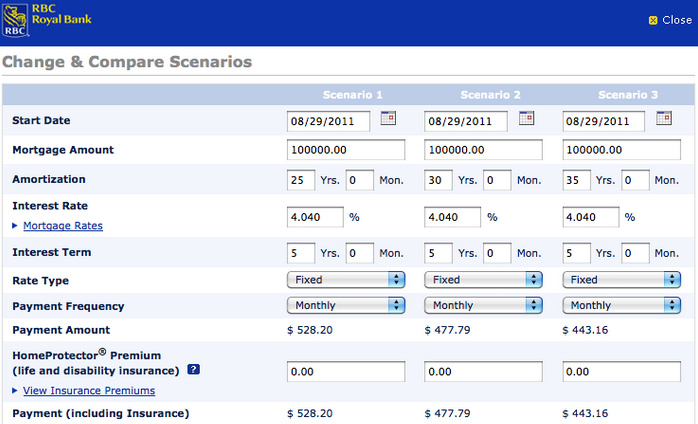
Banks are great at developing tools that their target audience will use time and time again. Something as simple as a mortgage calculator is a great resource that their sales team can share over email and even on social media. Tools like a mortgage calculator are also great opportunities to generate a series of back links from other sources such as financial bloggers who found this tool relevant and important.
Another example of someone in the B2B space who has gone on record talking about the value of tools is Neil Patel of QuickSprout and KISSmetrics. Neil created the QuickSprout website analyzer which provides informative marketing data and reports. You plug in a website URL into this form:
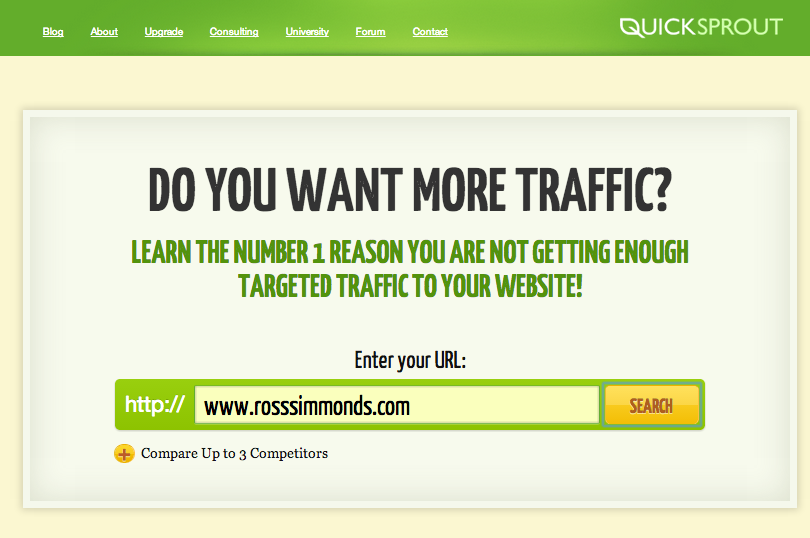
And within seconds are provided with a handful of great information about how your site is doing on social media, search and in comparison to competitors. Developing and distributing a tool like this is a great way to uncover who may be interested in your services and potential clients. While Neil doesn’t often offer SEO services to clients, there’s no question that a marketing firm would benefit from creating a tool like this and offering it up to potential prospects and leads. For Neil, this tool benefits his ability to tell his story as a marketer and establish brand leadership for his software and public speaking businesses through association.
In a recent blog post, Neil expressed that he spent $45,000 to build this free website analyzer and within the first four days 17,747 people ran 22,562 URLs through his free tool. Some of the key learnings and conclusions that Neil came to about this tool was the fact that (1) His audience saw the tool as higher value than his ongoing content efforts and (2) if he decided to monetize the event, he could generate more than $50k a month in revenue.
It might be time for you to consider putting your efforts into developing a tool.
Offer A Series Of Value Over Email
In B2B, it’s a competitive advantage to know something that your competitor doesn’t know. It’s also an opportunity for a professional to impress their employer and ultimately get a raise or promotion. As such, the best professionals and even the best companies, are looking to invest in training and professional development opportunities. If your brand can develop content that is considered valuable to the industry, you can not only generate revenue through your information but also potential leads.
One of the most effective ways to deliver value on a consistent basis over email is in the form of an online course. It’s easy to set up but requires a commitment to developing a course program that can be consumed through a series of email and other content you create. To get started with the development of an online course, you need to identify the type of content your audience will want. Once you’ve conducted a series of research that uncovers key audience intelligence, it’s time to start structuring the flow of your course.
The flow of your course should be separated by lessons & key deliverables. Here is an example of a two week structure that I developed for a course I delivered last year:
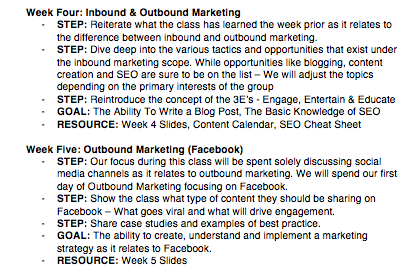
As you can see, I highlight the main topic at the top of the lesson followed by the key steps that will be taken throughout that course. Finally, I conclude by referencing the overall goal of this lesson along with the resources that the students will be provided. To deliver this course via email, the next step is to take this framework and turn it into actual content that can be shared over email.
Both MailChimp and ConvertKit are great resources for anyone looking to launch an online course. Of these two options, ConvertKit is likely to be the most intuitive as it’s made specifically for situations where you’re looking to deliver a drip email campaign to customers. This is what the ConvertKit interface looks like when you’re building a course:
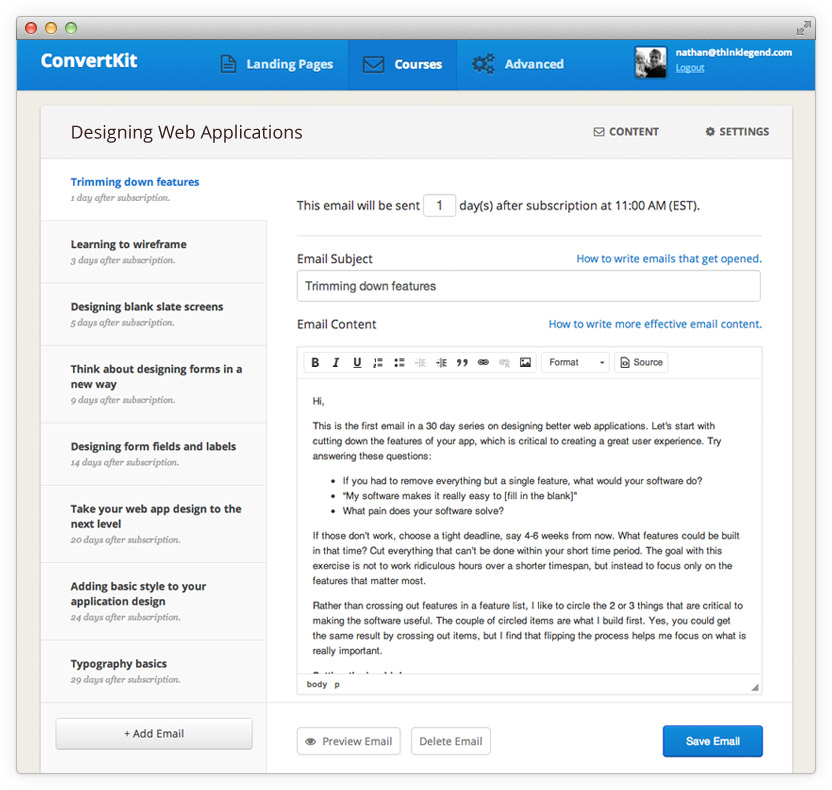
As you can see, the ability to select when the emails are sent to the user is a key part of making these courses feel real. If you simply set an ebook with a step by step guide to how these individuals can accomplish their goals, it would likely be completed in one sitting. The course approach puts your brand in their inbox on a regular basis and establishes a real relationship with the student. If you write the email correctly, the student will feel as if it’s actually you on the other end of every email and establish a feeling of trust.
Build An Amazing Industry Resource
One of the biggest SEO factors is gaining high quality back links to your pages. The better the content you develop, the more likely it is that you’ll generate back links from others in the industry.
An amazing industry resource is typically a piece of content that highlights a topic in depth. It could be in the form of text or it could be in the form of a video series. Either way, an industry resource that people see as providing value is often filled with data, insights and information. As a result, this content tends to be longer than average and this increased length has a positive effect on both shares and backlinks.
To demonstrate this, the folks at Moz.com visualized 500 posts based on word count, resulting in this graph from largest to smallest:
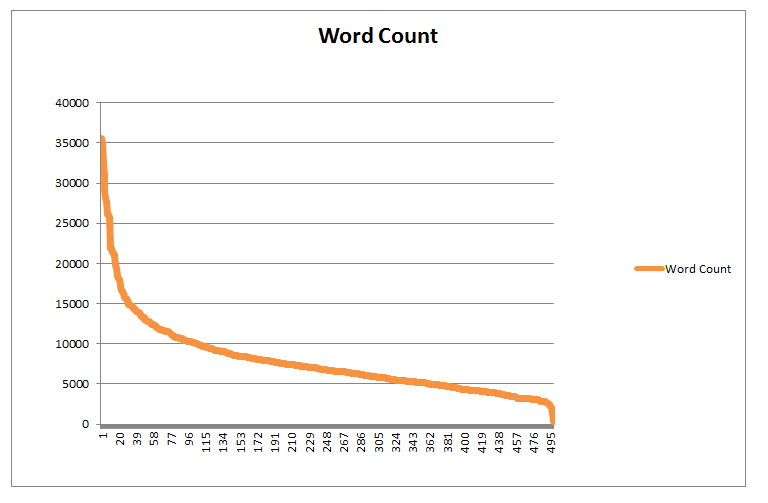
Without changing the order of the data, when Moz visualized the links that these posts have gained, there clearly seemed to be a correlation between longer content and links:
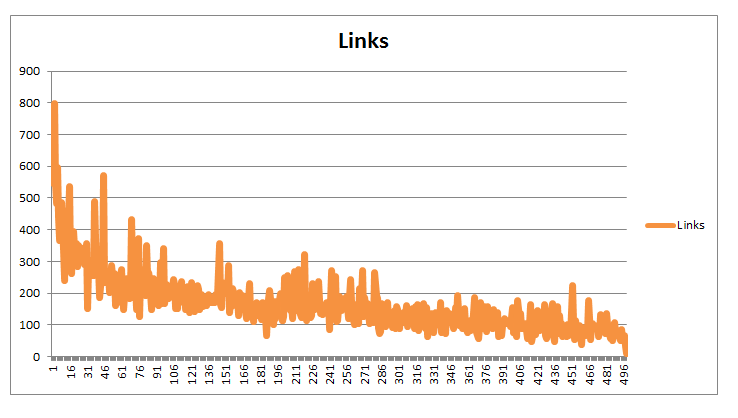
While I would never suggest that you solely focus on word count, I definitely would suggest that you focus on depth and the quality of your content. A lot of people like to believe that professionals are simply too busy to read long form content when that’s not entirely correct. In B2B it’s all about a competitive advantage. If you can deliver content that will give your prospects a chance to be better than their competition, they will not only read your content, they’ll share it internally for their colleagues and peers to check out as well.
An example of great industry content is the series of plans that are delivered on BodyBuilding.com. The content they deliver is informative, interactive and provides great value to anyone looking to get in shape or prepare for a bodybuilding competition.
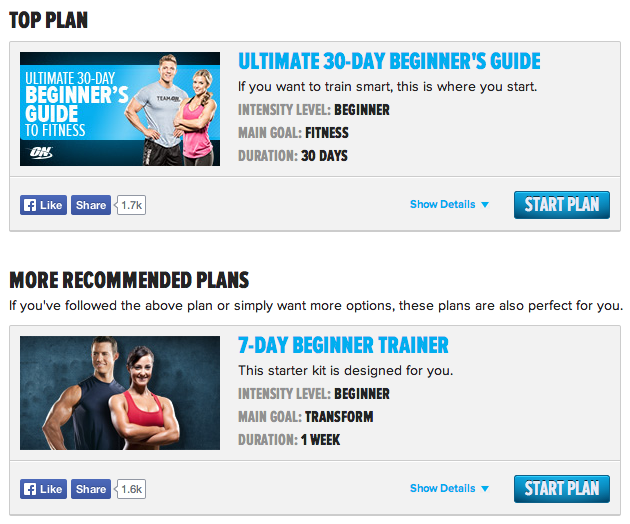
Not only are users provided with the ability to select their own individual needs, they are also able to submit their email to receive daily inspiration, meal plans and more directly to their inbox. A resource like this is a great benchmark for any content marketer looking at how they can develop an industry resource that people love and share.
At the end of the day, it all comes back to understanding your audience and providing them with the information they need to succeed. We live in a world where it’s no longer safe to keep your industry secrets hidden, if you want to succeed, you need to be willing to give before you get.
What do you think? What other types of content can a B2B marketer create to stand out?








